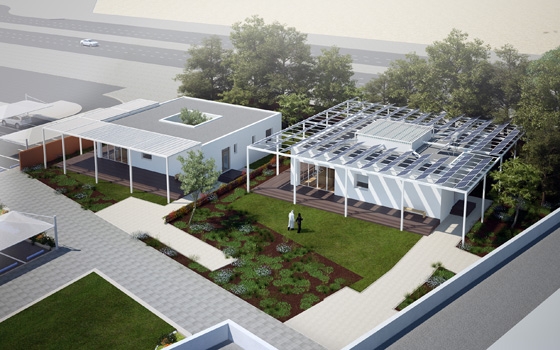Following months of planning, design and construction, Qatar Green Building Council (QGBC), Kahramaa and Barwa Real Estate Group (BRE) are celebrating the completion of Qatar’s first Passivhaus, marking a major shift in the country’s burgeoning construction industry.
The Passivhaus (“passive house” in English) villa is an ultra-low energy building, derived from a super insulated airtight building envelope, that requires little energy for cooling, reducing its environmental footprint. The building was officially opened today, alongside a conventional villa, under the joint project ‘Baytna.’
“This is a landmark day for Qatar’s construction industry. This successful partnership with Kahramaa, Barwa Real Estate Group and a host of local partners is a testament to what can be achieved with clear vision, collaboration and a will to make a positive change to the country’s carbon footprint. With the opening of Qatar’s first Case Study Passivhaus, we have paved the way for a more sustainable future for generations to come. By testing energy efficient solutions, we support Qatar’s shift from a carbon economy to a knowledge-based economy in line with the Qatar National Vision 2030”, said Eng. Issa Al Mohannadi, Chairman of Qatar Green Building Council and Chairman of Qatar Tourism Authority.
Under the Baytna project, two 225sqm villas have been constructed side by side in BARWA City for a comparative study on the benefits of the Passivhaus design in Qatar’s hot and arid climate. The Passivhaus villa has been designed with all the comforts of modern living while consuming at least 50 percent less energy, water and operational carbon dioxide emissions.
Eng. Ahmad Al Abdulla, Deputy Group CEO at Barwa Real Estate Group, said , “Today our ambitions are translated into actions on the ground; it is a pleasure and a great success for Barwa and all the partners in Baytna to be launching Qatar’s first Passivhaus, a pilot for more environmentally friendly and energy-efficient real estate around Qatar.”
“This experiment demonstrates Barwa’s ambitious environmental strategy inspired by Qatar National Vision 2030, which advocates sustainable practices not only in construction techniques, moreover, in every aspect of our daily lives as individuals. We extend thanks and appreciation to our guests today, and to those whose dedicated efforts brought Baytna to life. Expertise will now collaborate in monitoring the operation of the Passivhaus and its environmental effects,” added Eng. Al Abdulla.
Work begun in August 2012 and after eight months of construction, Baytna has successfully limited additional capital costs in construction of the Passivhaus to approximately 16 percent more than the conventional villa. The project’s initial aim was to keep the additional capital costs for the Passivhaus within 15 to 20 percent over the conventional villa’s costs.
The Baytna villas were inaugurated in an official ceremony on site today, in the presence of senior representatives from the Ministry of Environment, QGBC, BRE, Kahramaa and more than 50 partners who were involved in constructing the villas and equipping them with green technologies.
A six month period of testing and commissioning will now commence to compare the villas’ base line performance without occupants.
As a vehicle for advancing sustainable building research for the region, the project will also serve as a platform for comparative studies on cutting-edge sustainability technology and practice in a variety of areas including; converting sunlight to electricity with a photovoltaic array, alternative irrigation systems, localised water recycling, and sustainable soft-landscaping using local species of trees and shrubs.
QGBC, BRE and Kahramaa have established a scientific working committee to collaborate on the project’s many experiments, and conduct extensive monitoring of the Passivhaus principles and low-carbon technologies being implemented.
Following this testing and commissioning period of six months, the two villas will be occupied by two similarly-sized families, with at least one child, where further monitoring will take place for one year, as a real life demonstration of environmental principles in practice. The two families are expected to move into the three-bedroom demos by autumn 2013.
ifpinfo
22 April

























































